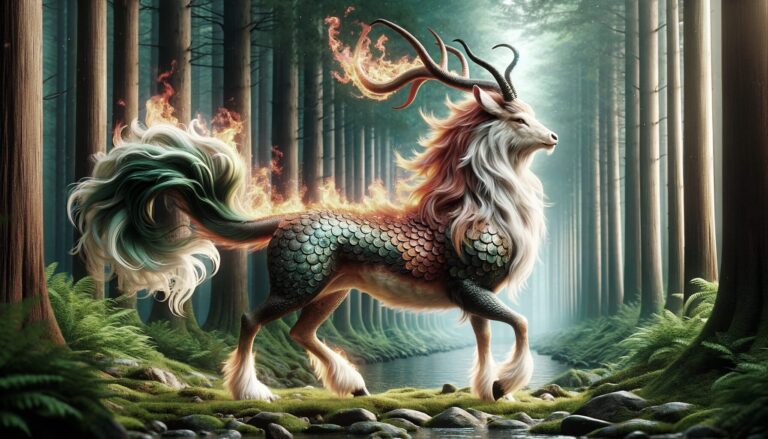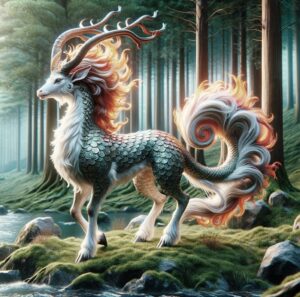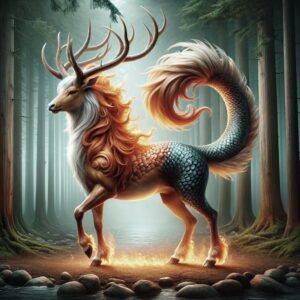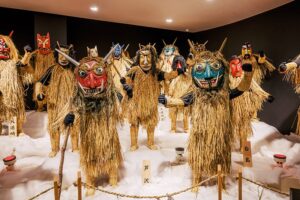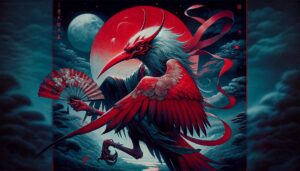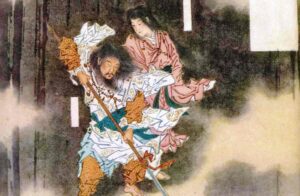Table of Contents
In Chinese mythology, the Kirin is one of the four noble animals, along with the Dragon, Phoenix, and Tortoise. It is believed to appear during times of peace and prosperity, heralding the arrival of a wise and just ruler or the birth of a great sage. The Kirin is also associated with bringing blessings and protection to those it encounters.
In Japanese mythology, the Kilin is called Kirin, and it is similarly associated with good omens, protection, and harmony. It is often depicted as a gentle and elegant creature and is sometimes associated with the Buddhist concept of compassion.
In Korean mythology, the Girin is considered a symbol of longevity and happiness, and it is believed to bring good fortune to those who encounter it.
Kirin is a mythical creature that represents positive qualities and is revered in various East Asian cultures for its association with good luck and auspicious events.
The origin of the Kirin (or Qilin in Chinese) is believed to date back to ancient Chinese mythology and folklore. Its earliest recorded references can be traced to ancient Chinese texts and literature, with some of the earliest mentions appearing in texts like the “Classic of Mountains and Seas” (Shan Hai Jing) and the “Zhuangzi.” These texts describe the creature as a mythical beast with auspicious qualities.
Over time, the concept of the Kirin spread to other East Asian cultures, including Japan and Korea, where it became known as the Kirin or Kilin and the Girin, respectively. While the creature’s appearance and attributes may have evolved somewhat in each culture, its fundamental association with good fortune, benevolence, and protection remained consistent.
The Kirin’s popularity and symbolism continued to grow over the centuries, and it became an integral part of East Asian folklore, art, and culture. It is often depicted in paintings, sculptures, and various forms of traditional art as a symbol of auspiciousness and blessings.
The exact origins of the Kirin remain somewhat mysterious, but its enduring presence in East Asian mythology and its widespread association with positive qualities have made it an iconic and beloved mythical creature in the region.
Physical Description
The physical description of the Kirin (or Qilin in Chinese) can vary somewhat in different depictions and cultural interpretations, but it generally includes the following characteristics:
Deer-like Body: The Kirin is typically described as having a body similar to that of a deer, with slender legs and a graceful posture. It may have a deer’s head, complete with antlers or horns.
Ox-like Tail: One of the distinctive features of the Kirin is its long, tufted tail, which is often likened to that of an ox or a lion. The tail is said to be adorned with fur or hair.
Hooves: The Kirin is usually depicted with cloven hooves, which are similar to those of other hoofed animals like deer or goats.
Scales or Fire: Some depictions of the Kirin include scales on its body, giving it a slightly dragon-like appearance. In other interpretations, the Kirin is described as having a mane or flames of fire that surround its body.
Gentle Expression: Kirins are typically portrayed with a serene and gentle expression, emphasizing their benevolent nature and the aura of peace and prosperity they bring.
Horns or Antlers: While not always present, some Kirin depictions include one or more horns or antlers on their heads, which can vary in shape and style.
Coloration: The coloration of the Kirin’s fur or scales can vary, but it is often associated with auspicious and vibrant colors such as gold, green, blue, or multi-colored patterns.
Symbolism: The Kirin is often seen as a symbol of good fortune, protection, and harmony, and its physical appearance reflects these positive attributes.
In East Asian mythology and folklore, the Kirin (or Qilin) is typically described as having a gentle and benevolent personality. Prsonality traits and attributes associated with the Kirin:
Benevolence: The Kirin is often seen as a symbol of goodness and benevolence. It is believed to be a kind and compassionate creature, radiating a sense of serenity and peace.
Protector: The Kirin is considered a protective being, and it is said to offer its protection to virtuous and righteous individuals. It is associated with safeguarding against evil and bringing blessings to those it encounters.
Symbol of Good Fortune: The Kirin is strongly linked to good fortune, prosperity, and positive outcomes. Its presence is believed to bring luck and auspiciousness to people and events.
Wisdom: In some traditions, the Kirin is associated with wisdom and sagacity. It is seen as a creature that possesses great knowledge and insight, and its appearance is often interpreted as a sign of wise leadership.
Peaceful Nature: The Kirin is known for its peaceful demeanor and is said to avoid causing harm or conflict. It treads lightly and does not harm living creatures, symbolizing harmony in the natural world.
Connection to Nature: The Kirin is often associated with the natural world and the balance of nature. Its presence is thought to harmonize with the environment and promote ecological balance.
Shyness: Some stories depict the Kirin as a shy and elusive creature that avoids human contact. It is said to appear only during times of great virtue or significant events.
Symbol of Transformation: The Kirin is sometimes associated with the idea of transformation or rebirth, symbolizing the renewal of life and the emergence of better times.
Special Abilities
The Kirin (or Qilin) is a mythical creature in East Asian folklore and mythology, and it is often attributed with various special abilities and qualities. These abilities can vary depending on different cultural interpretations, but some common attributes and special abilities associated with the Kirin include:
Detection of Virtue: One of the most well-known abilities of the Kirin is its ability to detect and recognize virtue in individuals. It is said to appear only in the presence of those who are exceptionally virtuous, just, and righteous.
Harbinger of Good Fortune: The Kirin is often considered a symbol of good fortune and prosperity. Its presence is believed to bring blessings, wealth, and positive outcomes to people and events.
Protector Against Evil: The Kirin is seen as a guardian against evil spirits and malevolent forces. It has the power to ward off harm and protect those who are in danger.
Gentle Nature: The Kirin is known for its gentle and benevolent nature. It does not harm or cause conflict and is considered a peaceful creature.
Fire Control: In some depictions, the Kirin is associated with the element of fire. It can control or breathe fire, which is often seen as a symbol of purification and transformation.
Wisdom and Insight: The Kirin is often associated with wisdom and great insight. It possesses knowledge of hidden truths and is a symbol of sagacity.
Healing Abilities: In some traditions, the Kirin is believed to have the power to heal ailments and injuries. Its presence is associated with physical and spiritual healing.
Ecological Harmony: The Kirin is sometimes seen as a guardian of nature and is associated with the balance of ecosystems. Its presence is thought to bring harmony and ecological balance to the environment.
Transformation: Some stories depict the Kirin as a creature of transformation or rebirth, symbolizing the renewal of life and the emergence of better times.
In Modern Usage and Symbolism
In modern usage and symbolism, the Kirin (or Qilin) continues to hold significance in East Asian cultures, albeit in a more symbolic and cultural context rather than a literal belief in its existence. Here are some aspects of modern usage and symbolism associated with the Kirin:
Corporate and Branding: The Kirin is often used as a symbol in branding and corporate logos in East Asia, especially in Japan. The Kirin Brewery Company, for example, is a well-known Japanese beer company that uses the Kirin as its logo.
Cultural Symbols: The Kirin remains an important cultural symbol in East Asian countries, representing values such as benevolence, wisdom, and protection. It is often incorporated into art, architecture, and traditional clothing.
Festivals and Celebrations: The Kirin may make appearances in various festivals and celebrations, where it symbolizes good luck and positive energy. Parades and performances featuring Kirin imagery can be seen during cultural events.
Spiritual and Religious Contexts: In some modern spiritual and religious practices, the Kirin may be invoked or depicted as a guardian or protector, believed to bring blessings and ward off negativity.
Art and Entertainment: The Kirin continues to inspire artists, writers, and creators in various forms of modern art, literature, and entertainment, where it represents positive and aspirational qualities.
Diplomacy and International Relations: The Kirin has been used in diplomatic gifts and exchanges between East Asian countries as a symbol of goodwill, peace, and cooperation.
National Symbols: In some countries, the Kirin has been adopted as a national symbol, emblem, or mascot to represent the unique cultural heritage and values of the region.
Contemporary Interpretations: Some contemporary interpretations of the Kirin may incorporate its symbolism into modern narratives and storytelling, highlighting its enduring relevance.
Kirin’s symbolism in modern usage reflects its continued significance as a cultural and historical icon in East Asian societies. It serves as a reminder of traditional values, positive qualities, and the cultural richness of the region. While it is not a literal belief in a mythical creature, the Kirin’s symbolic presence remains an integral part of East Asian cultural identity.
Ralated and similar creatures
Various cultures around the world have their own mythical creatures that share similarities or serve similar symbolic purposes to the Kirin (or Qilin) in East Asian mythology. Here are some related and similar creatures from different cultures:
Unicorn: In Western mythology, the unicorn is a legendary horse-like creature with a single spiral horn on its forehead. Like the Kirin, the unicorn is often associated with purity, grace, and rare beauty. It symbolizes qualities such as innocence and magic.
Griffin: The griffin is a creature from ancient Greek and medieval European mythology. It typically has the body of a lion and the head and wings of an eagle. Griffins are often considered guardians of treasure and symbols of strength and majesty.
Chimera: In Greek mythology, the Chimera is a fire-breathing creature with the body of a lion, the head of a goat, and the tail of a serpent. It is often seen as a symbol of chaos and danger.
Sphinx: The Sphinx is an ancient Egyptian and Greek mythical creature with the body of a lion and the head of a human or other animal. It is known for its riddles and enigmatic nature.
Dragon: Dragons are prevalent in many cultures worldwide, including Chinese, European, and Middle Eastern mythology. While they can have various forms and attributes, dragons are often associated with power, wisdom, and sometimes chaos.
Phoenix: In Greek and Egyptian mythology, the phoenix is a mythical bird that is cyclically reborn from its ashes. It represents renewal, immortality, and the sun’s life-giving qualities.
Thunderbird: In Native American mythology, the thunderbird is a powerful and majestic bird associated with thunder and lightning. It is often considered a symbol of protection and supernatural power.
Garuda: In Hindu and Buddhist mythology, the Garuda is a mythical bird-like creature known for its strength and speed. It serves as the mount of the god Vishnu and is often depicted as a guardian spirit.
Simurgh: In Persian mythology, the Simurgh is a magnificent and benevolent bird that is often associated with wisdom and the nurturing of life. It is similar to the phoenix in some aspects.
Nian: In Chinese mythology, the Nian is a fearsome creature that terrorizes villages during the lunar New Year. It is similar to the Kirin in that it is repelled by loud noises and the color red.
